
a)

Interpretation:
To predict the product of the reaction shown with regiochemistry, if relevant.
Concept introduction:
Catalytic hydrogenation is a heterogeneous process which occurs with syn stereochemistry. Both hydrogens adsorbed on the catalytic surface add to the double bond from the same face.
To predict:
The product of the reaction shown with regiochemistry, if relevant.
Answer to Problem 42AP
The product of the reaction is ethylbenzene.

Explanation of Solution
The addition of hydrogen takes place to the double bond in the side chain with syn stereochemistry. Both hydrogens add to the double bond from the same face to yield ethylbenzene.

The product of the reaction is ethylbenzene.
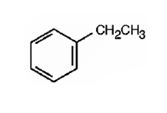
b)
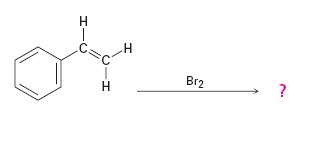
Interpretation:
To predict the product of the reaction shown with regiochemistry, if relevant.
Concept introduction:
Addition of bromine to the double bond in
To predict:
The product of the reaction shown with regiochemistry, if relevant.
Answer to Problem 42AP
The product of the reaction is
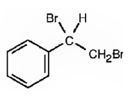
Explanation of Solution
In the first step the addition of bromine to the double bond in 1,2-dimethylcyclohexane results in the formation of a cyclic bromonium ion with the simultaneous elimination of a bromide ion. The large bromonium ion shields one side of the molecule. Hence the attack of the bromide ion occurs from the opposite, unshielded side to yield a trans-product.

The product of the reaction is
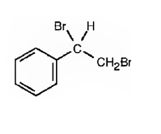
c)
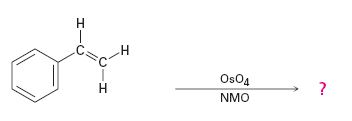
Interpretation:
To predict the product of the reaction shown with regiochemistry, if relevant.
Concept introduction:
Hydroxylation of double bonds can be carried out directly by treating the alkene with osmium tetroxide, OsO4, in the presence of N-phenylmorpholine N-oxide. The reaction occurs with syn stereochemistry through the formation of a cyclic intermediate, called osmate, formed by the addition of OsO4 to the alkene in a single step. The cyclic osmate is then cleaved to give the cis-1,2-
To predict:
The product of the reaction shown with regiochemistry, if relevant.
Answer to Problem 42AP
The product of the reaction is
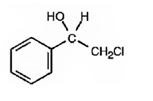
Explanation of Solution
OsO4 adds to the double bond in the side chain from the same side to yield a cyclic osmate in a single step. When treated with NaHSO3 the cyclic osmate gets cleaved to give the diol.

The product of the reaction is
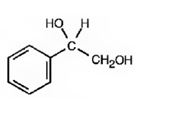
d)

Interpretation:
To predict the product of the reaction shown with regiochemistry, if relevant.
Concept introduction:
The addition of chlorine to alkenes in the presence of water results in the anti addition of the halohydrin, HOCl, to the double bond. In the first step a cyclic chloronium ion is formed by the attack of the π electrons of the double bond on chlorine. In the second step water attacks the chloronium ion from the least shielded side to give an anti addition product. The addition obeys Markovnokov orientation. The negative part (OH) adds to the doubly bonded carbon atom which has more number of substituents.
To predict:
The product of the reaction shown with regiochemistry, if relevant.
Answer to Problem 42AP
The product of the reaction is
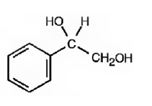
Explanation of Solution
The given alkene has an unsymmetrically substituted double bond in the side chain. In the first step a cyclic chloronium ion is formed by the attack of the double bond on chlorine. In the second step water attacks the the chloronium ion from the opposite less shielded side to give an intermediate which then loses a proton to yield the product.

The product of the reaction is
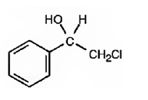
e)

Interpretation:
The product expected in the reaction shown is to be given.
Concept introduction:
The reaction given is an example of Simmons-Smith reaction. When CH2I2 is treated with Zn/Cu couple, iodomethylzinc iodide, ICH2ZnI, is formed. This ICH2ZnI transfers a CH2 group to the double bond in alkene to form a cyclopropane ring in the product.
To give:
The product expected in the reaction shown.
Answer to Problem 42AP
The product expected in the reaction shown is

Explanation of Solution
When CH2I2 is treated with Zn/Cu couple, iodomethylzinc iodide, ICH2ZnI, is formed. This ICH2ZnI transfers a CH2 group to the double bond in the side chain to form a cyclopropane ring in the product.
The product expected in the reaction shown is

f)
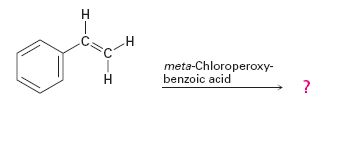
Interpretation:
The product expected in the reaction shown is to be given.
Concept introduction:
Alkenes are oxidized to give
To give:
The product expected in the reaction shown.
Answer to Problem 42AP
The product expected in the reaction shown is

Where RCO3H = meta-chloroperoxybenzoic acid
Explanation of Solution
The oxygen transfer from the peroxy acids to the double bond in the side chain takes place with syn stereochemistry. Both the C-O bonds are formed from the same face of the double bond through a one step process without the formation of an intermediate to yield the product.

The product expected in the reaction shown is

Want to see more full solutions like this?
Chapter 8 Solutions
Organic Chemistry
- 36) Complete the following multi-step reactions showing applications of enolate ions arising from ketones, esters, malonic ester, and keto ester, etc. (30 pts) (1) A NaOH, H₂O+ heat A NaOEt EtO OEt (11) EOH, H+ H. B LDA, H₂O+ -78°C B (i) NaOMe, Et-Br (ii) H₂O+, heat EtOOC (III) COOEt B A (i) NaOEt LiAlH 4-bromo-2-butene H₂O+ (ii) H3O+, heat Write the mechanism for Aldol Condensation (I A or B), and Claisen Condensation (II A).arrow_forward31) Complete two sets of reactions involving (R)-4-methyl-pent-2-ol producing racemic mixture of tertiary alcohols (D) and ketone derivative (C). Illustrate the mechanism of B and C or D. (25 pts) O OH 0 K2Cr2O7 Ph-CH2-Br, Mg, H2SO4 THF, H3O* (A) (D) Racemic mixture TsCl, Py (B) KCN, DMSO Ph-CH2-Br, Mg, THF, H3O+ (C) Mechanism for reactions B and C:arrow_forwardManoharan Mariappan, Ph.D., Dept. of Natur. Sci., NFC, Tallahassee, FL 33) Synthesize the aromatic compound containing para-substituted carbonyl compound starting from benzene. Illustrate the mechanism for reaction A. 1) NU (25 pts) A FeCl B (i) HNO3, H2SO4 (II) Sn, HCl(aq) NH₂ NO₂-D NH₂ (i) MeCO2Me, heat C (ii) K2Cr2O7/H2SO4 D (ii) SOCl2 (iii) 2 Et-NH2 Mechanism for reaction for the nitration of alkyl benzene (B-i): Characterize the product compound arising from the reaction D by IR and IH NMR spectral data: IR data (cm): 'H NMR data: Draw the structure and assign the chemical shift with the spin-splitting.arrow_forward
- Write structural formulas for the major products by doing addition reactions 1. You must add H2 as Pt is catalyst it does not take part in reactions only speed up the process H₂ CH2=CH-CH3 Pt 2. Add HCI break it into H and Cl CH3 HCI 3. Add Br2 only CC14 is catalyst CH3-CH=CH2 B12 CCl4 4. Add water to this and draw major product, H2SO4 is catalyst you have add water H20 in both the reaction below H₂SO4 CH3-CH=CH2 CH3 H2SO4/H₂O CH3-C=CH2 reflux ?arrow_forwardPlan the synthesis of the following compound using the starting material provided and any other reagents needed as long as carbon based reagents have 3 carbons or less. Either the retrosynthesis or the forward synthesis (mechanisms are not required but will be graded if provided) will be accepted if all necessary reagents and intermediates are shown (solvents and temperature requirements are not needed unless specifically involved in the reaction, i.e. DMSO in the Swern oxidation or heat in the KMnO4 oxidation). H Harrow_forwardHint These are benzene substitution reactions. ALCI3 and UV light are catalyst no part in reactions and triangle A means heating. A. Add ethyl for Et in benzene ring alkylation reaction EtCl = CH3CH2CL 1) EtC1 / AlCl3 / A ? B: Add Br to benzene ring ( substitution) 2) Br₂ / uv light ? C Add (CH3)2 CHCH2 in benzene ring ( substitution) (CH3)2CHCH,C1 / AICI, ?arrow_forward
- Draw the mechanism to make the alcohol 2-hexanol. Draw the Mechanism to make the alcohol 1-hexanol.arrow_forwardDraw the mechanism for the formation of diol by starting with 1-pentanal in... basic conditions then acidic conditions then draw the mechanism for the formation of a carboxylic acid from your product.arrow_forwardIdentify each chiral carbon as either R or S. Identify the overall carbohydrates as L or Darrow_forward
- Ethers can be formed via acid-catalyzed acetal formation. Draw the mechanism for the molecule below and ethanol.arrow_forwardHOCH, H HO CH-OH OH H OH 11 CH₂OH F II OH H H 0 + H OHarrow_forwardDraw the mechanism for the formation of diol by starting with one pen and all in... basic conditions then acidic conditions then draw the mechanism for the formation of a carboxylic acid from your product.arrow_forward
 Organic ChemistryChemistryISBN:9781305580350Author:William H. Brown, Brent L. Iverson, Eric Anslyn, Christopher S. FootePublisher:Cengage Learning
Organic ChemistryChemistryISBN:9781305580350Author:William H. Brown, Brent L. Iverson, Eric Anslyn, Christopher S. FootePublisher:Cengage Learning Organic Chemistry: A Guided InquiryChemistryISBN:9780618974122Author:Andrei StraumanisPublisher:Cengage Learning
Organic Chemistry: A Guided InquiryChemistryISBN:9780618974122Author:Andrei StraumanisPublisher:Cengage Learning


